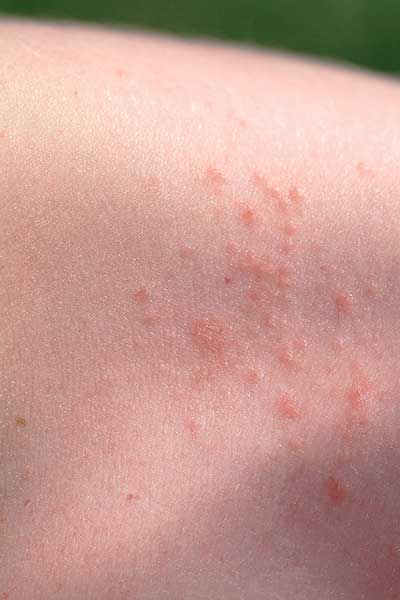About heat rash or prickly heat
Heat rash happens when the sweat glands get blocked and inflamed. If this happens, sweat can get trapped under the skin and small spots or blisters can develop.
Heat rash is very common in newborn babies in the first weeks of life.
In older children and teenagers, it can happen because of:
- overheating – for example, from overdressing
- hot or humid environments
- fever
- skin dressings or greasy ointments
- intense sweating from physical exercise.
Heat rash is also called prickly heat or miliaria.
Symptoms of heat rash or prickly heat
Heat rash looks like very small spots or blisters with clear fluid. On children and teenagers with light skin, the spots or blisters might look red. On children and teenagers with dark skin, the spots or blisters might look brown, purple or grey.
The number of spots or blisters varies. They might cover a large area of the body or a small area like a skin fold. They most commonly appear over the face, neck and torso.
Heat rash is often very itchy.
The blisters can get inflamed. Sometimes they get infected with bacteria. If this happens, the blisters might fill with yellow or white pus. Your child might have a fever and increased sweating over their body.

Medical help: when to get it for children and teenagers with heat rash
Usually heat rash goes away by itself.
You should take your child to the GP if your child has:
- blisters filled with yellow pus
- spots or blisters that last more than 3 days
- a rash and is also generally unwell, has a fever, or isn’t feeding or eating well.
Not every rash is just a heat rash. Check with your GP if you’re worried or in any doubt about the rash. Your GP can tell you what the rash is.
Treatment for heat rash or prickly heat
You can usually treat heat rash at home by making sure your child stays cool and dry and avoids getting sweaty. These tips might help.
Babies and young children
- Avoid too many layers when you wrap your baby or dress your child.
- Change wet nappies regularly.
- Gently dry your child’s skin folds after each bath.
All ages
- If you live in a hot climate, use air conditioning or keep your child in a comfortably cool place if possible.
- Ensure bedrooms are cool and ventilated.
- Choose light, loose-fitting and breathable clothing.
- Remove sweaty clothes.
- Try a bath in lukewarm water to help with itchiness.
- Avoid soap, because this can irritate the skin. Use a soap-free wash or a moisturising lotion or bath oil if needed.
If your child is scratching a lot, speak to your GP or other health professional about creams that might help. These might include a light, moisturising lotion or corticosteroid cream. If you can minimise your child’s scratching, you can reduce the risk of your child getting a bacterial infection that spreads from one spot to another.
With treatment, the rash should disappear in 2-3 days, but it can take longer than this.
Prevention of heat rash or prickly heat
Prevent heat rash by making sure your child doesn’t get too hot and sweaty. The treatment steps above can also help to prevent heat rash.